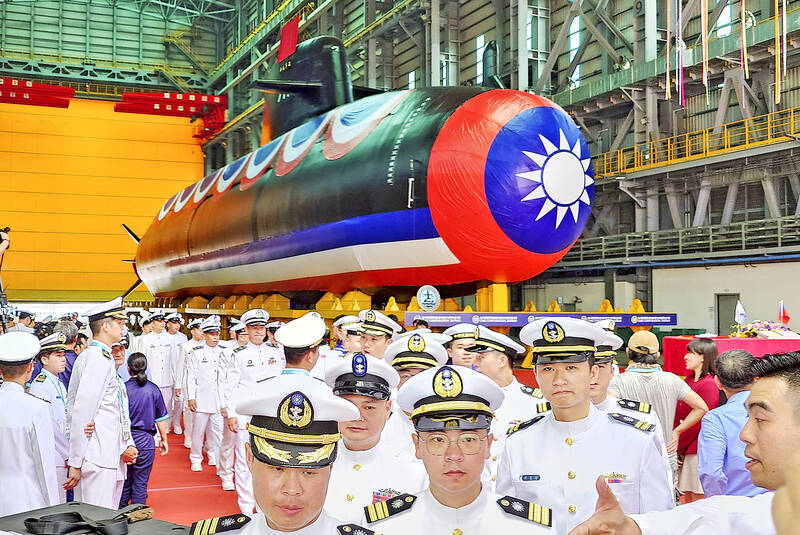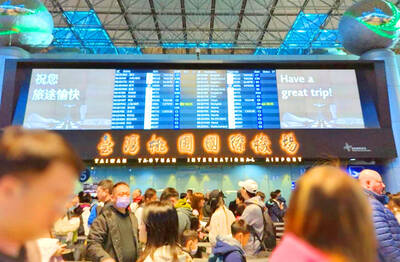A Taiwanese defense expert on Thursday said that the Hai Kun (海鯤), or “Narwhal,” submarine would boost the nation’s defense capabilities and could deter Chinese aircraft carriers and amphibious landing groups in eastern Taiwan, when it starts active service at the end of next year.
Institute of National Defense and Security Research fellow Su Tzu-yun (蘇紫雲) said the submarine would play a vital role in enhancing Taiwan’s combat readiness in waters to the east of the nation.
Su’s comments were made following the unveiling of Taiwan’s first indigenous defense submarine, named Narwhal, in Kaohsiung earlier on Thursday.

Photo: Chiang Ying-ying, AP
Submarines have the ability to effectively control critical maritime passages such as the Bashi Channel, located between southern Taiwan and the Philippines, and the Miyako Strait in the East China Sea, Su said.
In the event of a blockade by the Chinese People’s Liberation Army (PLA), the submarine can serve as vital counter-blockade asset, Su said, adding that domestically-produced submarines not only contribute to military strength, but also bolster economic development.
Meanwhile, Chieh Chung (揭仲), an associate research fellow at the National Policy Foundation in Taipei, said that during wartime, a sufficient number of submarines could be stationed in strategically chosen underwater ambush points around Taiwan, and they can be used to launch attacks against passing PLA fleets or high-value targets such as amphibious assault ships.
However, if the People’s Liberation Army Navy (PLAN) were to occupy these ambush areas, which are mostly near eastern Taiwan, with a few near Keelung in northern Taiwan and Kaohsiung in the south; it would enable Chinese forces to blockade Taiwan, restricting the movement of Taiwanese aircraft, he said.
It is important to increase the nation’s submarine fleet, Chieh said.
Lin Yin-yu (林穎佑), an assistant professor at Tamkang University’s Graduate Institute of International Affairs and Strategic Studies, said that based on previous PLAN military exercises, Chinese aircraft carriers have been more active in the western Pacific, apparently practicing establishing a naval blockade around Taiwan.
Lin said that if Taiwan’s military can develop sufficient underwater combat capabilities, it would be able to delay Chinese forces, thereby provide some additional response time.
The completion of the Narwhal means that the navy is on track to have a total of three combat-ready submarines by 2025 and four by 2027, including two existing Chien Lung-class subs bought from the Netherlands in the 1980s.

Three Taiwanese airlines have prohibited passengers from packing Bluetooth earbuds and their charger cases in checked luggage. EVA Air and Uni Air said that Bluetooth earbuds and charger cases are categorized as portable electronic devices, which should be switched off if they are placed in checked luggage based on international aviation safety regulations. They must not be in standby or sleep mode. However, as charging would continue when earbuds are placed in the charger cases, which would contravene international aviation regulations, their cases must be carried as hand luggage, they said. Tigerair Taiwan said that earbud charger cases are equipped

Foreign travelers entering Taiwan on a short layover via Taiwan Taoyuan International Airport are receiving NT$600 gift vouchers from yesterday, the Tourism Administration said, adding that it hopes the incentive would boost tourism consumption at the airport. The program, which allows travelers holding non-Taiwan passports who enter the country during a layover of up to 24 hours to claim a voucher, aims to promote attractions at the airport, the agency said in a statement on Friday. To participate, travelers must sign up on the campaign Web site, the agency said. They can then present their passport and boarding pass for their connecting international

Temperatures in northern Taiwan are forecast to reach as high as 30°C today, as an ongoing northeasterly seasonal wind system weakens, the Central Weather Administration (CWA) said. CWA forecaster Tseng Chao-cheng (曾昭誠) said yesterday that with the seasonal wind system weakening, warmer easterly winds would boost the temperature today. Daytime temperatures in northern Taiwan and Yilan County are expected to range from 28°C to 30°C today, up about 3°C from yesterday, Tseng said. According to the CWA, temperature highs in central and southern Taiwan could stay stable. However, the weather is expected to turn cooler starting tonight as the northeasterly wind system strengthens again

Taiwan sweltered through its hottest October on record, the Central Weather Administration (CWA) said yesterday, the latest in a string of global temperature records. The main island endured its highest average temperature since 1950, CWA forecaster Liu Pei-teng said. Temperatures the world over have soared in recent years as human-induced climate change contributes to ever more erratic weather patterns. Taiwan’s average temperature was 27.381°C as of Thursday, Liu said. Liu said the average could slip 0.1°C by the end of yesterday, but it would still be higher than the previous record of 27.009°C in 2016. "The temperature only started lowering around Oct. 18 or 19